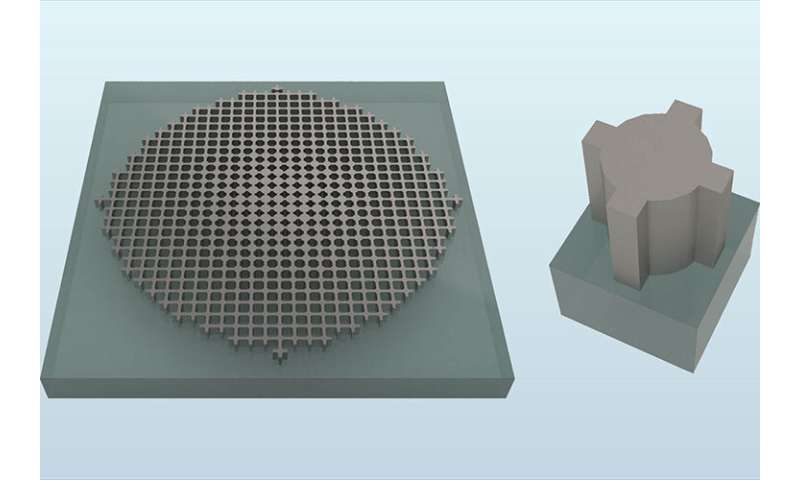#Record-breaking metalens could revolutionize optical technologies
“#Record-breaking metalens could revolutionize optical technologies”

Traditional lenses—like the ones found in eyeglasses—are bulky, heavy and only focus light across a limited number of wavelengths. A new, ultrathin metalens developed by researchers at the University of California, Berkeley, uses an array of tiny, connected waveguides that resembles a fishnet to focus light at wavelengths spanning from the visible to the infrared with record-breaking efficiencies.
Unlike traditional lenses, the metalens is flat and compact and could be made small enough to fit inside increasingly miniaturized devices. The development could lead to game-changing advances in solar energy, virtual reality technology, medical imaging, information processing with light and other applications reliant upon optics.
“We have overcome what was regarded as a fundamental roadblock,” said study principal investigator Boubacar Kanté, associate professor of electrical engineering and computer sciences at UC Berkeley and faculty scientist at Lawrence Berkeley National Laboratory. “This is, simply, the thinnest, most efficient, broadest band flat lens in the world.”
The new technology, named the “Fishnet-Achromatic-Metalens (FAM),” is described in a study that appeared online June 25 in the journal Nature Communications.
While many methods have been proposed to implement flat lenses over the past decade, the arrival of the new metalens is the first time this combination of properties has been achieved.
The team demonstrated the ability of its fishnet-achromatic-metalens to capture 70% of incoming light in frequencies ranging from 640 nanometers (reddish-orange light) to 1,200 nanometers (infrared light). Light entering the fishnet metalens within that broad octave band of wavelengths would be focused at a single point on the other side of the lens.
“We are very excited by these results because many applications required the simultaneous processing of multiple wavelengths in a broad spectrum,” said Kanté. “This is the case for solar energy applications where we need to focus all colors of light for efficient solar cells or solar concentrators.”
A good next step, Kanté said, would be to develop processes that could enable larger scale production.
More information:
Abdoulaye Ndao et al. Octave bandwidth photonic fishnet-achromatic-metalens, Nature Communications (2020). DOI: 10.1038/s41467-020-17015-9
Record-breaking metalens could revolutionize optical technologies (2020, June 26)
retrieved 26 June 2020
from https://phys.org/news/2020-06-record-breaking-metalens-revolutionize-optical-technologies.html
This document is subject to copyright. Apart from any fair dealing for the purpose of private study or research, no
part may be reproduced without the written permission. The content is provided for information purposes only.
If you want to read more Like this articles, you can visit our Science category.
if you want to watch Movies or Tv Shows go to Dizi.BuradaBiliyorum.Com for forums sites go to Forum.BuradaBiliyorum.Com


